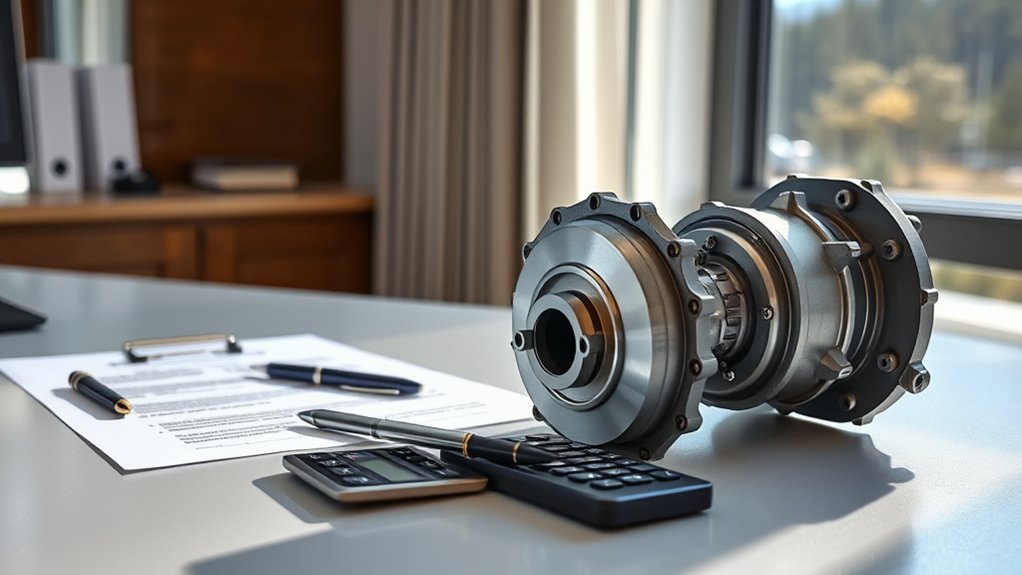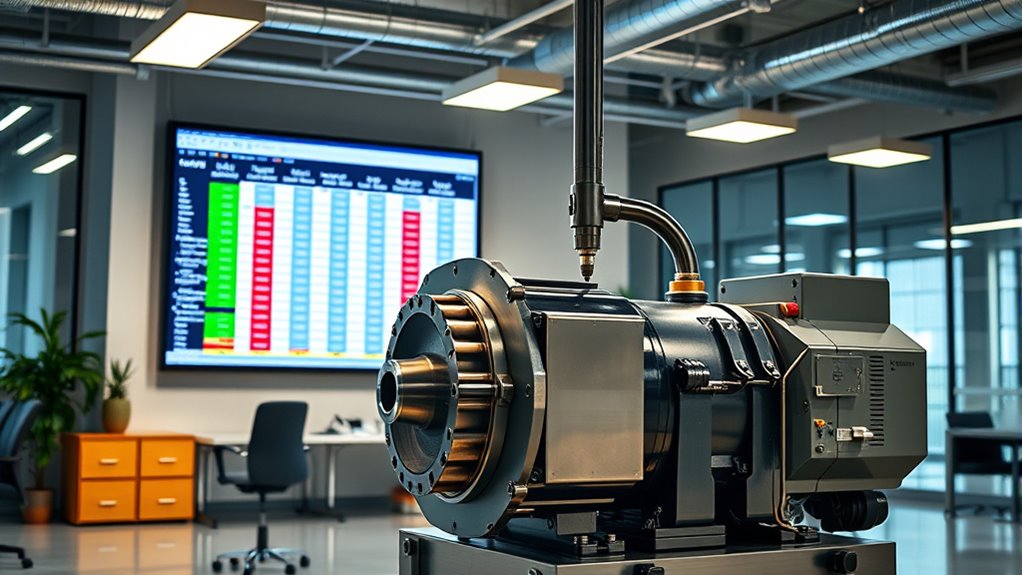To maximize your first-year depreciation benefits, you should aim to purchase and place qualified assets in service before the bonus depreciation rate drops from 100% to 80% in 2025. Act now to take advantage of current laws that allow full expensing on machinery, equipment, and other eligible items. Planning your acquisitions strategically guarantees you capture the maximum deduction possible. Keep in mind, understanding eligibility and timing can boost your tax savings—if you continue further, you’ll learn how to make this happen effectively.
Key Takeaways
- Acquire eligible assets before December 31, 2024, to maximize 100% bonus depreciation benefit.
- Ensure property qualifies (tangible, MACRS 20 years or less, used in trade/business).
- Properly document acquisition and placement in service dates to support bonus depreciation claims.
- Consult IRS Form 4562 to explicitly elect and claim the bonus depreciation deduction.
- Act now to leverage current law reinstating full 100% bonus depreciation through 2025 before gradual phase-out.
Understanding Bonus Depreciation and Its Benefits

Bonus depreciation is a powerful tax tool that allows you to write off a large portion of your eligible business assets in the first year instead of spreading the deduction over their useful life. This serves as a key investment incentive, helping you accelerate deductions and improve cash flow. By claiming bonus depreciation, you markedly lower your taxable income during the acquisition year, which enhances your tax planning strategies. It applies to machinery, equipment, and qualified property bought and placed in service during the tax year. Calculating the deduction is straightforward: multiply the depreciation rate by the asset’s cost basis. Reporting involves filing IRS Form 4562 and making an explicit election. Utilizing bonus depreciation effectively can lead to substantial tax savings, supporting your business growth and investment efforts. Bonus depreciation is also subject to legislative changes and phased-out percentages over time, so staying informed is essential. Additionally, understanding the depreciation rules can help maximize your benefits and ensure compliance with current tax laws.
The Timeline of Bonus Depreciation Phase-Out

The timeline of bonus depreciation phase-out has evolved considerably since its introduction under the Tax Cuts and Jobs Act (TCJA) in 2017. Initially, you could claim 100% bonus depreciation immediately, but a scheduled phase-out began in 2023, reducing the percentage by 20 each year until 2027. This meant you’d see tax credits decrease from 80% in 2023 to zero in 2027. However, the One Big Beautiful Bill Act (OBBBA) reinstated 100% bonus depreciation starting January 20, 2025, for assets placed in service through 2029. This change markedly alters depreciation methods, allowing full deductions for eligible property over multiple years. It removes the original phase-out schedule, giving you a clearer timeline and more predictable tax planning for capital investments. This extension provides greater certainty for businesses planning large capital expenditures, especially with the advancements in Hyundai tuning that can improve vehicle value and performance.
How Legislation Has Extended 100% Bonus Depreciation

How did legislation successfully extend 100% bonus depreciation beyond its scheduled phase-out? The key was the 2025 Tax Reform Legislation, known as the “One Big Beautiful Bill Act” (OBBBA). This legislative update permanently restores 100% bonus depreciation for qualified property placed in service after January 19, 2025. It cancels the original phase-down schedule from the 2017 Tax Cuts and Jobs Act, which aimed for a gradual reduction by 2027. This change reflects a deliberate tax policy shift to encourage business investment and provide long-term certainty. By permanently reinstating full bonus depreciation, lawmakers ensure businesses can immediately deduct the cost of qualifying assets, fostering capital expenditure planning and economic growth. The bill also included provisions for a full first-year deduction for qualified production property (QPP), which further incentivizes manufacturing and U.S.-based production. Additionally, this legislative update recognizes the importance of tax incentives in shaping investment strategies and economic development, making it a significant development for businesses planning their capital expenditures. This legislative update appreciably influences tax strategies and investment planning going forward.
Identifying Qualifying Property for Immediate Deduction

To qualify for immediate deduction, you need to identify the right types of property that meet IRS criteria. Eligible assets include tangible items like machinery, equipment, and certain improvements, but land itself doesn’t qualify. Make sure the property was acquired and placed in service within the required timeframes to take advantage of bonus depreciation.
Eligible Asset Types
Eligible assets for immediate depreciation include most tangible personal property with a MACRS recovery period of 20 years or less, excluding building structures and land. Your asset classifications determine whether property qualifies, based on its recovery period. Common qualifying items include machinery, equipment, furniture, fixtures, and business-use vehicles—especially those in the 3-, 5-, 7-, 10-, 15-, or 20-year classes. Software that meets IRS criteria and is off-the-shelf can also qualify. Conversely, property with recovery periods over 20 years, such as real estate, or intangible assets like trademarks, do not qualify. Land and assets acquired from related parties or via inheritance are excluded. Make sure the property is placed in service in the year of acquisition to meet bonus depreciation rules. Additionally, understanding farmhouse bedroom design elements can help create a cozy, rustic environment that enhances the overall space.
Acquisition and Usage Rules
Determining whether property qualifies for immediate depreciation hinges on specific acquisition and usage criteria. You must acquire the asset within designated dates, ensuring it’s “original use” (new to you) and placed in service in the same tax year. Used property generally doesn’t qualify unless specified by transition rules, and properties under binding contracts before the law’s effective date are excluded. For construction, significant work must occur after the effective date. The property must also meet all applicable requirements in §§ 1.168(k)-2(b)(2) through 2(b)(5). Asset valuation must reflect the purchase price at acquisition. Business use must predominate, usually over 50%, to avoid depreciation recapture. Property cannot be held solely for sale or investment. Acquisition from unrelated parties is typically required unless special rules apply. Proper documentation is vital to substantiate timing, valuation, and usage for compliance. Recognizing the importance of tax law compliance can help ensure the asset qualifies for the immediate depreciation benefit.
Strategic Planning for Asset Purchases in 2024 and Early 2025

To optimize your tax benefits, you need to plan your asset purchases carefully for 2024 and early 2025. Timing your acquisitions before the end of 2024 can maximize bonus depreciation, but you should also stay alert to legislative changes that could impact deductions. By strategically managing when and how you buy assets, you can enhance cash flow and reduce tax liabilities effectively. Additionally, understanding sound recording techniques can help ensure your investments in equipment yield the best quality for your money.
Timing Asset Acquisition Strategically
Strategic timing of asset purchases can considerably impact your first-year depreciation benefits, especially as tax laws and bonus depreciation rates shift between 2024 and early 2025. If you place assets in service before year-end 2024, you’ll benefit from the 80% bonus depreciation rate, but waiting until 2025 could allow you to claim 100%. Proper planning around property valuation and depreciation schedules ensures you maximize deductions. Timing also influences how quickly you can utilize Section 179 limits and avoid phase-outs. Small delays or early placements can make a significant difference in your tax savings. By aligning asset acquisition with legislative changes, you can optimize depreciation benefits and preserve cash flow. Additionally, considering the availability of portable camping gear options can help ensure your assets are ready for deployment at the optimal time.
Maximize Bonus Deduction Opportunities
Maximizing bonus depreciation opportunities requires careful planning around asset placement and timing. To leverage tax incentives fully, you should prioritize acquiring eligible property—such as machinery, vehicles, or interior upgrades—early in the year and ensure it’s placed in service before December 31. This allows you to take advantage of the highest bonus rates available, especially before they phase down. Understanding depreciation schedules is essential, as bonus rates decrease from 60% in 2024 to 20% in 2026. Timing asset placement strategically maximizes immediate deductions and improves cash flow. Maintain thorough documentation of service dates and asset qualification to substantiate your claims. Proper planning guarantees you capture the maximum bonus deduction, optimizing your tax benefits during the phaseout period. The bonus depreciation percentage also depends on the month in which the asset is placed in service, so early acquisition can significantly enhance your deduction.
Monitor Legislative Changes Closely
Keeping a close eye on legislative developments is essential for optimizing your asset purchase strategy in 2024 and early 2025. Legislative updates and policy shifts can dramatically change depreciation rules, so timely adjustments are indispensable. You must monitor key dates, such as the phasedown from 100% bonus depreciation to 80%, and the recent law that restores 100% bonus depreciation after January 19, 2025. Staying informed helps you plan asset acquisitions to maximize deductions before rules change. Proper assessment of property details is also crucial, as accurate information can impact your eligibility for accelerated depreciation benefits. – Track IRS guidance and congressional updates regularly – Watch for new legislation like the “One Big Beautiful Bill Act” – Confirm placed-in-service dates align with depreciation deadlines – Adjust strategies based on inflation-related deduction limits – Verify property qualification and use requirements amid policy shifts
Legal Requirements for Claiming First-Year Bonus Depreciation

To claim first-year bonus depreciation, you must meet specific legal requirements that guarantee your property qualifies under IRS rules. First, your property must be used in a trade or business or for income production, including certain real estate improvements and tangible assets like machinery, equipment, or computers with a recovery period of 20 years or less under MACRS. Both new and used property can qualify if they meet IRS criteria, such as being acquired from an unrelated party and satisfying original use rules. The asset must be placed in service during the tax year, and you must elect to claim the depreciation by attaching IRS Form 4562 to your return. Additionally, the property should be mainly used for business purposes, and intangible assets or land generally don’t qualify. Proper documentation is essential to support your claim. Efficient general ledger coding can assist in tracking and documenting assets for compliance and audit purposes.
Maximizing Tax Savings Before the Bonus Depreciation Schedule Changes

With the reinstatement of 100% bonus depreciation starting in 2025, now is the ideal time to accelerate your asset purchases and capitalize on immediate tax savings. By strategically timing your acquisitions, you can maximize deductions through asset valuation and optimize your tax planning. Acting now ensures you lock in full expensing before the phasedown begins in 2027, which could limit your benefits. Consider re-evaluating your capital projects to align with the current schedule, especially for assets like machinery, equipment, or qualified improvements. Early placement of assets in service allows you to benefit from full bonus depreciation, boosting cash flow and reducing taxable income. Proper planning now can set you up for substantial savings before policy changes take effect.
Act now to maximize 2025 bonus depreciation and lock in full expensing before phasedown in 2027.
- Evaluate asset valuation techniques to maximize depreciation deductions
- Schedule purchases early in 2025 to secure full bonus expensing
- Use cost segregation to accelerate depreciation on real estate assets
- Reassess your capital budget for strategic timing and tax benefits
- Incorporate bonus depreciation into your long-term tax planning strategies
Frequently Asked Questions
How Does Placing an Asset in Service Differ From Purchasing It?
When you place an asset in service, you’re marking it as ready for use, which triggers its classification for depreciation schedules. This differs from purchasing because the purchase date is simply when ownership transfers, but depreciation begins only once the asset is operational and available for its intended purpose. Knowing this distinction helps you maximize tax benefits and properly manage your depreciation planning.
Can Used Property Qualify if It Was Previously Used in Another Business?
Think of used property as a fresh canvas, even if it’s been painted before. If it was previously used in another business, it can still qualify for bonus depreciation, provided it meets specific IRS criteria. You must guarantee it’s not from a related party, not previously used by you or your predecessor, and acquired under the right conditions. Proper documentation and timing are your keys to opening this depreciation opportunity.
What Documentation Is Required to Substantiate Bonus Depreciation Claims?
To substantiate your bonus depreciation claims, you need supporting documentation like invoices, purchase orders, and contracts that prove your property was acquired after September 27, 2017, and placed in service within the required period. You should also keep proof of purchase, such as receipts, showing the asset’s cost basis. These documents help verify eligibility, calculation accuracy, and compliance with IRS requirements for bonus depreciation.
Are There Specific Asset Classes That Do Not Qualify for Bonus Depreciation?
Certain asset classes, like land and land improvements, simply don’t qualify for bonus depreciation because they aren’t depreciable or don’t meet qualifying criteria. Property with a recovery period exceeding 20 years, intangible assets, and leased or related-party assets also fall outside the bonus depreciation box. You need to carefully scrutinize these asset classes, ensuring they meet the qualifying criteria to maximize your depreciation benefits and avoid costly missteps.
How Do Changes in Bonus Depreciation Laws Affect Multi-Year Asset Purchases?
Changes in bonus depreciation laws substantially impact your tax planning and asset classification strategies. With the reinstatement of 100% bonus depreciation for assets placed in service after January 19, 2025, you should time your multi-year asset purchases accordingly. Proper asset classification ensures you maximize immediate deductions, while understanding the law’s permanence helps you plan investments confidently. Delaying purchases to avoid phasedown isn’t necessary anymore, so focus on operational needs and strategic asset placement.
Conclusion
So, while you still have the chance to capitalize on 100% bonus depreciation, don’t wait too long—because soon, that generous boost will fade away. It’s almost poetic how this golden opportunity is slipping through your fingers just when you’re starting to get the hang of it. Act now, maximize your deductions, and enjoy the irony of watching a once-rare benefit become a thing of the past—before it’s too late.









